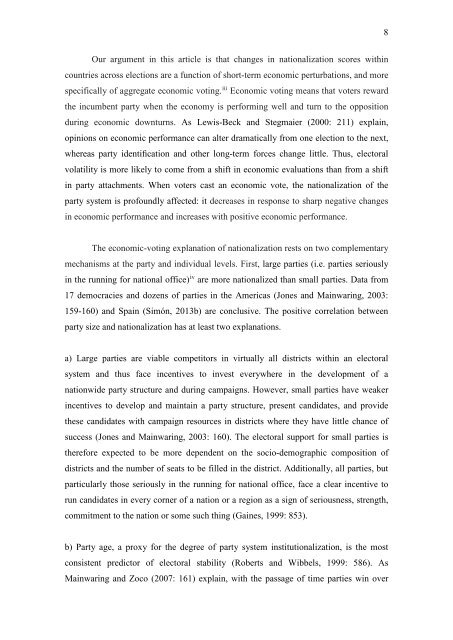AN ECONOMIC EXPLANATION OF THE NATIONALIZATION OF ELECTORAL POLITICS
n?u=RePEc:gov:wpaper:1602&r=fdg
n?u=RePEc:gov:wpaper:1602&r=fdg
Create successful ePaper yourself
Turn your PDF publications into a flip-book with our unique Google optimized e-Paper software.
8<br />
Our argument in this article is that changes in nationalization scores within<br />
countries across elections are a function of short-term economic perturbations, and more<br />
specifically of aggregate economic voting. iii Economic voting means that voters reward<br />
the incumbent party when the economy is performing well and turn to the opposition<br />
during economic downturns. As Lewis-Beck and Stegmaier (2000: 211) explain,<br />
opinions on economic performance can alter dramatically from one election to the next,<br />
whereas party identification and other long-term forces change little. Thus, electoral<br />
volatility is more likely to come from a shift in economic evaluations than from a shift<br />
in party attachments. When voters cast an economic vote, the nationalization of the<br />
party system is profoundly affected: it decreases in response to sharp negative changes<br />
in economic performance and increases with positive economic performance.<br />
The economic-voting explanation of nationalization rests on two complementary<br />
mechanisms at the party and individual levels. First, large parties (i.e. parties seriously<br />
in the running for national office) iv are more nationalized than small parties. Data from<br />
17 democracies and dozens of parties in the Americas (Jones and Mainwaring, 2003:<br />
159-160) and Spain (Simón, 2013b) are conclusive. The positive correlation between<br />
party size and nationalization has at least two explanations.<br />
a) Large parties are viable competitors in virtually all districts within an electoral<br />
system and thus face incentives to invest everywhere in the development of a<br />
nationwide party structure and during campaigns. However, small parties have weaker<br />
incentives to develop and maintain a party structure, present candidates, and provide<br />
these candidates with campaign resources in districts where they have little chance of<br />
success (Jones and Mainwaring, 2003: 160). The electoral support for small parties is<br />
therefore expected to be more dependent on the socio-demographic composition of<br />
districts and the number of seats to be filled in the district. Additionally, all parties, but<br />
particularly those seriously in the running for national office, face a clear incentive to<br />
run candidates in every corner of a nation or a region as a sign of seriousness, strength,<br />
commitment to the nation or some such thing (Gaines, 1999: 853).<br />
b) Party age, a proxy for the degree of party system institutionalization, is the most<br />
consistent predictor of electoral stability (Roberts and Wibbels, 1999: 586). As<br />
Mainwaring and Zoco (2007: 161) explain, with the passage of time parties win over


